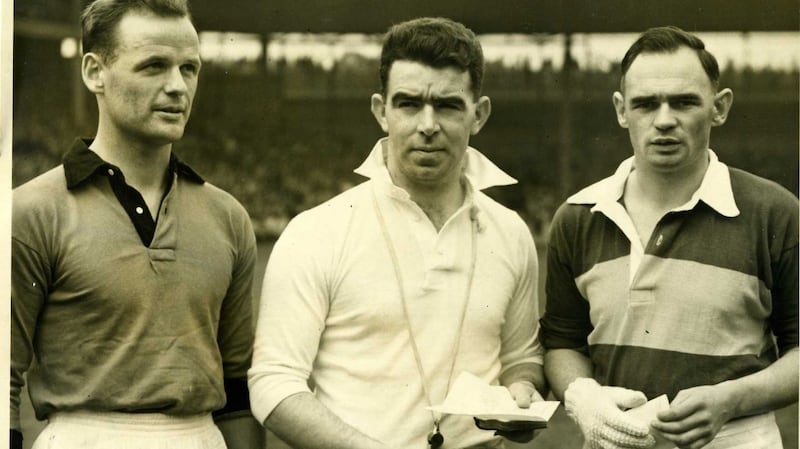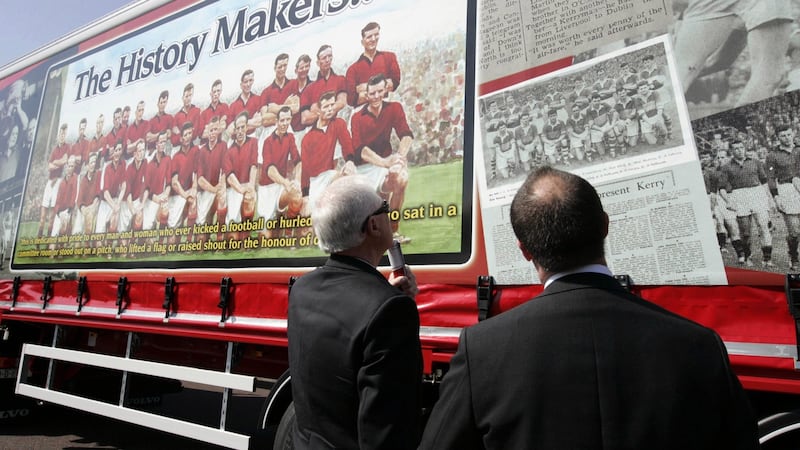Of all the many conversations I've had over the years about the rise of the 1960 Down team, one in particular stands out to this day. And it wasn't with a player, a manager or a pundit. It was with a self-proclaimed hard-line unionist called George Graham from Kilkeel back in 1982 when he was chairman of the Newry and Mourne Council.
He was not, it is fair to say, a man who wore his beliefs lightly. However, one night following a council meeting, we got into a conversation about sport leading into Gaelic football. Much to my surprise he reeled off six or seven names from the famous All-Ireland winning side – more than 20 years after the event – and recalled, with quite a measure of impression, the excitement in the county when they brought the Sam Maguire cup across the Border for the first time.
“You didn’t expect to hear that from me, did you?’ he finally said, and went off with a contented grin.
A few days following that victory over Kerry, the story is well told of a Protestant postman knocking on the door of one of the Down footballers and proclaiming: “Well done! Well done! Ye bate the bastards!”
The sudden rise of Down as a force in Gaelic football brought a surge of colour, charisma, daring, defiance, sheer fitness and brilliance of teamplay not seen before, attracted the greatest crowds in the history of the game, stirred the imagination of the country and enthralled all sections of the community north of the Border.

It was the largest gathering of people on the island of Ireland since Daniel O'Connell's monster meeting at <a class="search" href='javascript:window.parent.actionEventData({$contentId:"7.1213540", $action:"view", $target:"work"})' polopoly:contentid="7.1213540" polopoly:searchtag="tag_location">Tara</a> back in 1843
No side from the Six Counties had been able to break the hoodoo in All-Ireland semi-finals and finals: Armagh in 1950 and '53, Antrim in '51, Tyrone in '56 and '57, Derry in '58 and up-and-coming Down in '59 – something akin to the Mayo impasse of modern times.
But the rise of Down did not just happen. It was highly organised. Following a first-round championship defeat by Armagh in 1957, the county secretary Maurice Hayes and other officials assembled a group of players in Newcastle GAA grounds and presented his plans for a radical new approach. The overall philosophy was to aim higher, reach further, dig deeper than anything previously undertaken in Gaelic football. If everybody committed themselves totally to the challenge, he promised they would be All-Ireland champions in three years.
Down had no championship tradition and had not even won an Ulster title at that stage.
Hardened
After their first victory in Ulster in 1959, they were defeated by Galway in the All-Ireland semi-final, but retained their provincial title in 1960 and were growing all the time. The two struggles against Offaly in the semi-finals had matured and hardened the side, twice coming back from the jaws of defeat – and now something utterly unthinkable a few years earlier was on the cards: an All-Ireland final confrontation with Kerry. Expectation was in full spate. It made the front-page headline of the Sunday Press: “All set for epic final.”
And so, on that September Sunday morning of the final in 1960, Down supporters checked their cars and vans for oil and water for the long journey, checked the tyres, maybe the points and plugs as well, and headed off in their Austin 7s, 10s, 12s and 16s, Morris 10s, Morris Minors, Ford Prefects, Bedford vans, Zodiacs, Consuls, A-30s, Volkswagen Beetles, Citroëns, Hillman Minxes, Rover 2000s, Anglias, Humbers and Morris Major vans through the bottlenecks of Newry, Dundalk, Castlebellingham, Dunleer, Drogheda, Julianstown, Balbriggan and Swords, on past Dublin Airport and down into the cauldron of Drumcondra – and suddenly straight ahead was the great elevation of the new Hogan stand.
To the left of that was the more venerable Cusack stand which had a Down connection in that Michael Cusack taught in St Colman's College, Newry from 1871 to 1876 and in 1882 founded the Dublin Hurling Club, said to be the nucleus of the GAA which came two years after. Listed on that hurling team were several Co Down Protestants including Rev Samuel Holmes and the brothers Frank and Robert Patterson from Newry.
By half three, a record 88,000 spectators had crammed into Croke Park. Tickets were only needed for the Hogan and upper Cusack. It was the largest gathering of people on the island of Ireland since Daniel O'Connell's monster meeting at Tara back in 1843.
Down footballers, officials, supporters and journalists from the time are adamant that considerable numbers of the Protestant population from across the county and beyond travelled to Croke Park in full support for the semi-finals and final. It seemed that the exploits of the team had created a sense of common belonging and self-worth; they knew that they wanted to celebrate but were not sure how, that it stirred something uplifting within them but they were not sure what, and that the success belonged to them as well but they were uncertain as to why.
Friendships
That campaign of 1960 was well remembered by North Down unionist politician Robert McCartney, as he told Eamonn Rafferty in the latter's book Talking Gaelic in 1997. It was only when he went to Queen's University in 1954 that he formed friendships with GAA people and started going to games. When Down rose to prominence he followed them enthusiastically to Croke Park for all the big games.
"I think, after all, that whether you are a Catholic or Protestant you get a kick out of Ulster teams winning in Croke Park. You can go back to Cú Chulainn or whatever, but an Ulsterman is an Ulsterman and he gets a buzz out of the likes of Derry, Donegal or Down bringing home the Sam Maguire."

The crossing of the Border with the Sam Maguire cup represented a genuine passing over, a coming of age, the entry of a new age of heroes
Sodilva Murphy, wife of the late Leo, the Down full-back, clearly remembers her Protestant neighbours coming to their house in Poyntzpass to listen to the Down games on the radio, and were totally into the excitement. Such was common in rural areas. Many others from that community were so caught up in the drama of it all, she remembered, that they travelled off to Croke Park for the games and were there afterwards in Newry for the triumphant homecoming.
I was a schoolboy in 1960 and for some reason found myself in my grandparents' house in Keady where it was half-time in the game. I counted nine visitors there sitting very tense-faced listening to the high-pitched voice of Michael O'Hehir who kept repeating that Down were ahead by two points. There was no Sunday Game in those pundit-free days. RTÉ didn't cover GAA matches on TV until 1962 and all those confined to listening to the radio saw the events at Croke Park in their own imaginations conducted by O'Hehir.
Excitable
As the match resumed I worked out that seven in the room including my granda – all Armagh people – were supporting Down. They included a highly excitable man sitting beside me who, when James McCartan scored a goal after about 10 minutes, literally sprung into life squealing at the top of his voice, “She’s comin’ across! She’s comin’ across!” (meaning the Sam Maguire was going to cross the border) his feet drumming up and down on the floor like pistons.
The excitement was now in full boil and, into the last eight minutes, Down were awarded a penalty. The room filled with mutterings and exclamations and a shifting in the seats and a great hush came over the radio as if there was nobody in Croke Park. If Paddy Doherty scored it was all over for Kerry, creating a gap of seven points. But to miss, apart from the dread of a tension-filled ending, would destroy the sheer beauty of Down's overall defiant display. The penalty had to be the coup de grace.
Then O’Hehir broke the lull. “And up he steps!”
No other broadcaster possessed such a vocal detonation of the phrase “it’s a goal”, sounding like the snarl of a cat in a midnight fight. The man beside me went into another craze of excitement with his feet in full revs as two listeners fled the house without a word. And then the final whistle sounded and, after a pause to let the roar of the crowd be heard, O’Hehir solemnly intoned the vast reality: “And Down are the All-Ireland champions.”
The crossing of the Border with the Sam Maguire cup represented a genuine passing over, a coming of age, the entry of a new age of heroes. The knowledge that Gaelic football in the Six Counties had triumphed obliterated the memories of the gallant 50s, and removed the Border as the psychological obstacle it had become in this regard. There had been no homecoming like it in the history of the GAA in terms of crowds and excitement.
All the way from Dublin the team were greeted in the various towns with jubilation as the cavalcade reached the Border at Killeen, where a grand crossing ceremony was organised by members of the local Cloghogue clergy and the adjacent Killeavy GFC. The Sam Maguire cup glistened and gleamed as Down captain Kevin Mussen, along with players and officials, stepped formally across the exact line of the Border to a wild fanfare of acclaim. After that historic gesture, it was on slowly down the hill into the waiting arms of Newry where tens of thousands had gathered from all over Ulster.
Eventually the team moved through the thronged villages of Mayobridge and Hilltown and into Castlewellan where the they were welcomed by the parish priest, Rev CJ Crossan, who was joined by Rev FN Warren of the Church of Ireland and Rev J Bridgett of the Presbyterian church along with the lord lieutenant for Co Down, Hon Gerald Annesley.
Night had fallen when the final destination of Newcastle was reached and the bus eased through the waiting crowds and entered the football grounds. There, the Sam Maguire cup was placed on the exact spot from where three years previously Maurice Hayes had made his prophesy.
Peter Makem is a native of Derrynoose, Co Armagh and former Armagh manager, winning the Ulster title in 1982. He lives in Newry and works as a writer with special interest in Gaelic football.


















